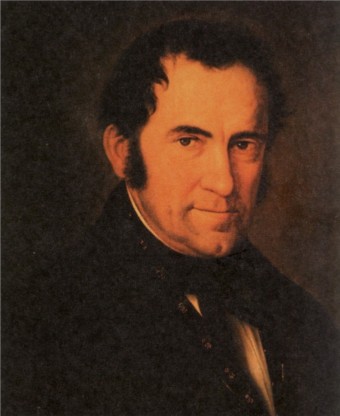This Day in History: December 24th- Silent Night
This Day In History: December 24, 1818
 On a cold Christmas Eve, Pastor Joseph Franz Mohr walked to the home of his friend Franz Xaver Gruber carrying a poem he had written two years earlier. He was in dire need of a Christmas carol for midnight mass and was hoping Gruber, a teacher who also served as the church organist and choir master, could set his poem to music on very short notice.
On a cold Christmas Eve, Pastor Joseph Franz Mohr walked to the home of his friend Franz Xaver Gruber carrying a poem he had written two years earlier. He was in dire need of a Christmas carol for midnight mass and was hoping Gruber, a teacher who also served as the church organist and choir master, could set his poem to music on very short notice.
Gruber was up for the challenge, and composed a melody that perfectly complemented Mohr’s verse expressing a yearning for heavenly peace, “Stille Nacht! Heilige Nacht! (Silent Night! Holy Night!).” The song was written for two voices, a choir and guitar accompaniment (most believe this was because the church organ was out of commission).
That very evening, on December 24, 1818, “Silent Night” was performed for the first time at St. Nicholas Church in Oberndorf, Austria. Mohr sang the tenor part and played the guitar while Gruber sang the bass vocals. Gruber recalled that the song was given “general approval by all” present at Mass – mostly boat builders and other laborers and their families.
“Silent Night” was crafted and first performed during very tumultuous times. The devastating Napoleonic wars had just ended, resulting in new borders and a new order for much of Europe. One of the changes wrought by the power shift was that the ecclesiastical Principality of Salzburg was no longer an independent country, and it was forced to secularize.
A portion of Salzburg was now Bavaria, while the other section became part of Austria. This took a huge toll on the local economy, and it was during those difficult days that Mohr wrote the words to “Silent Night” in 1816. The uncertainty and hardship of the times lends the verse its haunting, plaintive quality.
The song’s popularity grew quickly, thanks in part to the musical families of Rainer and Strasser who made it part of their repertoire and introduced the song to audiences in Leipzig in 1832, and then in New York in 1839.
“Silent Night” figured largely during the famous spontaneous, and quite amazing, Christmas Truce of World War I.
Around the turn of the 20th century, St. Nicholas Church was torn down, but was replaced with the Silent Night Memorial Chapel, which opened in 1937. Every Christmas Eve, thousands of people gather at the chapel to honor of Joseph Mohr and Franz Gruber. At the end of the service, participants are invited to sing “Silent Night” in their native language.
If you liked this article, you might also enjoy our new popular podcast, The BrainFood Show (iTunes, Spotify, Google Play Music, Feed), as well as:
- The Song “Jingle Bells” Is Thought to Have Been Written for a Thanksgiving Sunday School Program
- December 24, 1914: The Christmas Truce
- The Anonymous Publishing of “The Night Before Christmas,” and Other Interesting Christmas Staple Origins
- The Song “Silver Bells” was Originally Called “Tinkle Bell”
- Brenda Lee was Just 13 Years Old When She Recorded the Christmas Staple “Rockin’ Around the Christmas Tree”
| Share the Knowledge! |
|





Quoting from the article: “On a cold Christmas Eve, Pastor Joseph Franz Mohr walked to the home of his friend Franz Xaver Gruber carrying a poem he had written two years earlier. He was in dire need of a Christmas carol for midnight mass …”
As I have done so many times in the past, I again today urge the author to treat Catholicism with respect.
Nowhere in the article is the fact stated that the composer and lyricist of the musical work were Catholics — a point that should have been mentioned. This did not surprise me, because the author’s antipathy toward Catholicism has been evident in countless articles at “Today I Found Out.” How sad!
Could it have been an attempt, by the author, to hide the two men’s Catholicism that moved her to refer to the lyricist as “Pastor Joseph Mohr” (as one might refer to a Lutheran minister)? In reality, he should be referred to as “Father” (or “Reverend”) Joseph Mohr. (One will find “Vater” Joseph Mohr mentioned at various German-language Internet sites.) Father Mohr was not the “pastor”/”rector” of the parish, but rather the “assistant pastor” (often referred to now as the “parochial vicar”).
Finally, the author states that Fr. Mohr “was in dire need of a Christmas carol for midnight mass.” Within the context (use of music during a Catholic worship service), the priest would have wanted a melody for his “hymn” (not for a “carol,” a secular term) — and he desired it for use at “Mass” (not “mass”). In written English, Catholics always capitalize the “m” in “Mass,” as a sign of respect for this extremely sacred event.
By the way, in case any reader is wondering, “Mass” is not a short form of “mass meeting” or something of that nature. The derivation of the word has nothing to do with the gathering of a “mass” of people. A Mass can be celebrated even by a priest who is all alone.
Thank you for giving me a chance to share these corrections.
Merry Christmas to all!